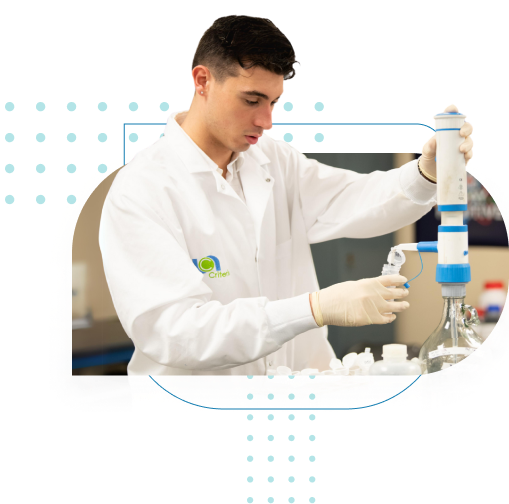PFAS
Testing
Sample Collection & Laboratory

Laboratory Testing of Drinking Water for Perfluoroalkyl and Polyfluoroalkyl substances (PFAS Testing) is the only way to accurately determine the PFAS contamination levels in your Drinking Water. PFAS Testing is surprisingly affordable, fast, and convenient with Criterion Labs.
Criterion is accredited by the EPA and PADEP to test for 29 PFAS Compounds using EPA Methods 533 and 537.1.
Criterion’s local community is asymmetrically affected by PFAS contamination, so we offer affordable PFAS testing to local residents and well-water users.
Criterion offers PFAS Testing to accurately determine the levels of PFAS contamination in your drinking water. Criterion’s PFAS Test Kits can be shipped or picked-up from our lab:
PFAS Test Kit:
18 PFAS Compounds, including: PFOS, PFOA, PFNA, PFHxS, PFHpA, PFBS
Criterion Laboratories
400 Street Rd.
Bensalem, PA 19020
(215) 244-1300
For information about Criterion’s Drinking Water Testing and PFAS Test Kits, click here or contact Criterion: (215) 244-1300.
PFAS Explained
Per- and Polyfluoroalkyl Substances, or PFAS for short, refer to a group of manufactured chemicals that are widely-used and break down very slowly over time. The PFAS group is comprised of many chemicals; PFOS and PFOA are the most widely-studied compounds in the PFAS group. Here are a list of 29 PFAS compounds that the EPA monitors, along with the analytical method of detection and the EPA’s Maximum Residue Level (MRL).
| Contaminant | Method | MRL [ug/L] |
| 11-chloroeicosafluoro-3-oxaundecane-1-sulfonic acid (11Cl-PF3OUdS) | 533 | 0.005 |
| 1H,1H, 2H, 2H-perfluorodecane sulfonic acid (8:2FTS) | 533 | 0.005 |
| 1H,1H, 2H, 2H-perfluorohexane sulfonic acid (4:2FTS) | 533 | 0.003 |
| 1H,1H, 2H, 2H-perfluorooctane sulfonic acid (6:2FTS) | 533 | 0.005 |
| 4,8-dioxa-3H-perfluorononanoic acid (ADONA) | 533 | 0.003 |
| 9-chlorohexadecafluoro-3-oxanonane-1-sulfonic acid (9Cl-PF3ONS) | 533 | 0.002 |
| hexafluoropropylene oxide dimer acid (HFPO-DA)(GenX) | 533 | 0.005 |
| nonafluoro-3,6-dioxaheptanoic acid (NFDHA) | 533 | 0.002 |
| perfluoro (2-ethoxyethane) sulfonic acid (PFEESA) | 533 | 0.003 |
| perfluoro-3-methoxypropanoic acid (PFMPA) | 533 | 0.004 |
| perfluoro-4-methoxybutanoic acid (PFMBA) | 533 | 0.003 |
| perfluorobutanesulfonic acid (PFBS) | 533 | 0.003 |
| perfluorobutanoic acid (PFBA) | 533 | 0.005 |
| perfluorodecanoic acid (PFDA) | 533 | 0.003 |
| perfluorododecanoic acid (PFDoA) | 533 | 0.003 |
| perfluoroheptanesulfonic acid (PFHpS) | 533 | 0.003 |
| perfluoroheptanoic acid (PFHpA) | 533 | 0.003 |
| perfluorohexanesulfonic acid (PFHxS) | 533 | 0.003 |
| perfluorohexanoic acid (PFHxA) | 533 | 0.003 |
| perfluorononanoic acid (PFNA) | 533 | 0.004 |
| perfluorooctanesulfonic acid (PFOS) | 533 | 0.004 |
| perfluorooctanoic acid (PFOA) | 533 | 0.004 |
| perfluoropentanesulfonic acid (PFPeS) | 533 | 0.004 |
| perfluoropentanoic acid (PFPeA) | 533 | 0.003 |
| perfluoroundecanoic acid (PFUnA) | 533 | 0.002 |
| N-ethyl perfluorooctanesulfonamidoacetic acid (NEtFOSAA) | 537.1 | 0.005 |
| N-methyl perfluorooctanesulfonamidoacetic acid (NMeFOSAA) | 537.1 | 0.006 |
| perfluorotetradecanoic acid (PFTA) | 537.1 | 0.008 |
| perfluorotridecanoic acid (PFTrDA) | 537.1 | 0.007 |
PFAS Testing Information
Sample Collection for PFAS Testing is simple! Please contact Criterion for a PFAS Testing and Sample Collection Guide: (215) 244-1300
Click Here to view the EPA’s Analytical Methods for PFAS Testing of Drinking Water